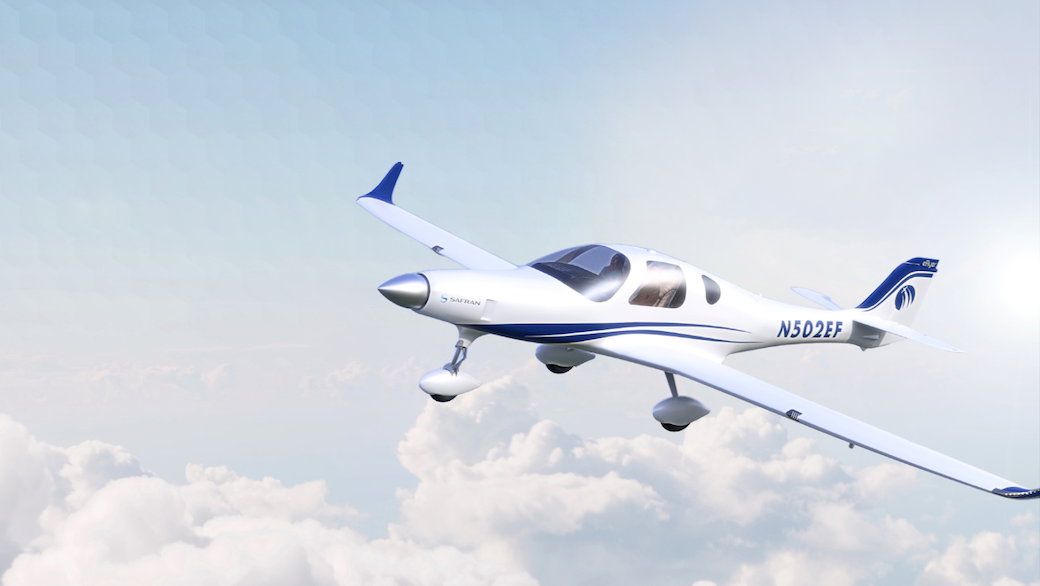This article is published in Advanced Air Mobility part of Aviation Week Intelligence Network (AWIN), and is complimentary through May 07, 2025. For information on becoming an AWIN Member to access more content like this, click here.

The eFlyer 2 is powered by a 110-kW Safran EngineUS 100 air-cooled electric engine.
Most flight schools operate with fairly slim profit margins. Given the high operating and maintenance costs and intense competition among flight schools, most are lucky to achieve a profit margin of 10-15%, while some even lose money.
In 2024, for example, Flight Safety International achieved a profit margin of 12.3% and ATP Flight School 8%, while CAE recorded a negative 1.9% margin, according to data from market research firm IBISWorld.
But what if there were an opportunity to improve those margins by achieving a step change in aircraft efficiency? That is the pitch of Bye Aerospace, the Colorado-based startup developing the eFlyer 2 battery-electric trainer.
“We believe we can disrupt this market by lowering the operating cost by up to 80% because we remove the cost of fossil fuel and lubricants, and because it’s a much simpler powertrain, a simpler aircraft and it was designed for maintainability and serviceability,” says CEO Rod Zastrow. “We think we can double, and potentially triple, their profits by a simple substitution of this aircraft for a legacy aircraft. That’s our principal mission: to bring lower operating costs to the flight training industry.”
Bye Aerospace in September announced it had begun construction of its first aircraft, serial number 0001, at its facilities at Centennial Airport in Denver. Zastrow says the company is now fabricating composite parts and validating its composite tooling, including a 40-ft. composite curing oven it developed in-house. The startup is being meticulously documented, to have the “option to earn FAA [certification] credit, potentially with this prototype,” he explains.
“It’s more than a prototype; it’s really more about building a full-scale aircraft that has the exact same shape as eFlyer 2 to prove out a lot of the aerodynamics,” Zastrow says. “It’s de-risking our program significantly because we validate those engineering principles and design concepts as we continue our full FAA certification campaign.”.”
With an achievable target endurance of 3 hours, and charging time of 20 min. for a typical training flight, Zastrow says the eFlyer2’s performance and reliability should “easily” be able to satisfy the “vast majority” of requirements for a pilot to earn a commercial license. He also says the design is intended to provide higher aircraft availability for flight schools, thus increasing their potential to train more student pilots and further increase their profitability.
The decision to develop an electric trainer is part of Bye Aerospace’s strategy to get a product to market “as quickly and low-cost as possible,” Zastrow says.
“We have an already certified electric engine, a modern clean-sheet aerodynamic design, and features that flight schools are requesting such as an unpressurized cockpit, no variable-pitch prop, no retractable landing gear,” he notes. “We can keep the design, the certification program and the production as simple as possible. That meshes well with what the training industry needs: a simpler aircraft that’s reliable and flies at much lower cost than the current aircraft in the training fleet.”
The eFlyer 2 is powered by a 130-kW Safran ENGINeUS 100 air-cooled electric engine. The battery supplier has yet to be announced.
Zastrow says that he expects the company to launch into flight testing with its prototype within 12 months, during which he anticipates continuing to complete the remaining roughly two-year type certification process.
The eFlyer2 is being certified under Amendment 64 of the FAA’s Part 23 ruleset.




